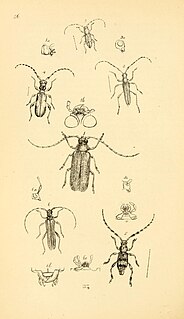
Germanus of Auxerre was a bishop of Auxerre in Late Antique Gaul. He abandoned a career as a high-ranking government official to devote his formidable energy towards the promotion of the church and the protection of his 'flock' in dangerous times: personally confronting, for instance, the barbarian king, "Goar". In Britain he is best remembered for his journey to combat Pelagianism in or around 429 AD, and the records of this visit provide valuable information on the state of post-Roman British society. He also played an important part in the establishment and promotion of the Cult of Saint Alban. The saint was said to have revealed the story of his martyrdom to Germanus in a dream or holy vision, and Germanus ordered this to be written down for public display. Germanus is venerated as a saint in both the Roman Catholic and Orthodox churches, which commemorate him on 31 July.

Saint Germanus I was Patriarch of Constantinople from 715 to 730. He is regarded as a saint, by both the Orthodox and Roman Catholic Churches, with a feast day of 12 May.
Germanus was an East Roman (Byzantine) general, one of the leading commanders of Emperor Justinian I. Germanus was Emperor Justinian's cousin, and a member of the ruling dynasty. He held commands in Thrace, North Africa, and the East against Persia, and was slated to command the final Byzantine expedition against the Ostrogoths. Having married into the Gothic Amal royal line through his second wife Matasuntha and a distinguished service record, at the time of his sudden death, he was considered the probable heir to Emperor Justinian.

Saint Alban is venerated as the first-recorded British Christian martyr, for which reason he is considered to be the British protomartyr. Along with fellow Saints Julius and Aaron, Alban is one of three named martyrs recorded at an early date from Roman Britain. He is traditionally believed to have been beheaded in the Roman city of Verulamium sometime during the 3rd or 4th century, and his cult has been celebrated there since ancient times.
Germanus is the Latin term referring to the Germanic peoples. A probably related meaning for the word in Latin is "brother", cognate to gernan "seed".

Xylotoles costatus, the Pitt Island longhorn beetle, is a species of beetle in the family Cerambycidae. It is endemic to New Zealand. Originally thought to be extinct in 1986, it was found again in 1996 on South East Island/Rangatira in the Chatham Islands; the species is now considered a Lazarus taxon.
Xylotoles is a genus of beetle in family Cerambycidae. It contains several species, including Xylotoles costatus, once thought extinct. The longhorn beetle belonging to genus Xylotoles is classified as Endangered (EN) on the IUCN Red List.
Germanus II Nauplius, was Patriarch of Constantinople from 1223 until his death in June 1240.

Theodosius was the eldest son of Byzantine Emperor Maurice and was co-emperor from 590 until his deposition and execution during a military revolt in November 602. Along with his father-in-law Germanus, he was briefly proposed as successor to Maurice by the troops, but the army eventually favoured Phocas instead. Sent in an abortive mission to secure aid from Sassanid Persia by his father, Theodosius was captured and executed by Phocas's supporters a few days after Maurice. Nevertheless, rumours spread that he had survived the execution, and became popular to the extent that a man who purported to be Theodosius was entertained by the Persians as a pretext for launching a war against Byzantium.
Papyrus Oxyrhynchus 95 is an agreement for the sale of a slave, written in Greek. It was discovered in Oxyrhynchus. The manuscript was written on papyrus in the form of a sheet. The document was written on 23 June 129. Currently it is housed in the library of the Royal Holloway College in Egham.
Dorcadiini is a tribe of longhorn beetles of the Lamiinae subfamily. It was described by Latreille in 1825.
Xylotoles scissicauda is a species of beetle in the family Cerambycidae. It was described by Bates in 1874. It is known from New Zealand.
Xylotoles nanus is a species of beetle in the family Cerambycidae. It was described by Bates in 1874. It is known from New Zealand.
Xylotoles nudus is a species of beetle in the family Cerambycidae. It was described by Bates in 1874. It is known from New Zealand. It contains the varietas Xylotoles nudus var. prolongatus.
Xylotoles segrex is a species of beetle in the family Cerambycidae. It was described by Olliff in 1889. It is known from Australia.
Xylotoles apicicauda is a species of beetle in the family Cerambycidae. It was described by Stephan von Breuning in 1943. It is known from New Zealand.
Xylotoles parvulus is a species of beetle in the family Cerambycidae. It was described by White in 1846. It is known from New Zealand.
Xylotoles traversii is a species of beetle in the family Cerambycidae. It was described by Pascoe in 1876. It is known from New Zealand.
Xylotoles selwini is a species of beetle in the family Cerambycidae. It was described by Olliff in 1888. It is known from Australia.

Xylotoles griseus, the fig longhorn, is a species of beetle in the family Cerambycidae. It was described by Johan Christian Fabricius in 1775, originally under the genus Saperda. It is known from New Zealand where it feeds on elm trees. It is widespread and common in New Zealand, breeding on many species of trees. It was found in the UK for the first time when a number of adults were taken from a recently felled fig tree at Westward Ho!, Devon in 2014.







